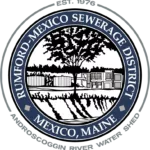
Understanding Wastewater: Key Terms from Your Sewerage District
Have you ever wondered what happens after you flush? Or what all those pipes and plants are really called? At the Rumford-Mexico Sewerage District, we believe that understanding wastewater terms helps everyone appreciate the vital work we do. Since 1971, our mission has been to keep water clean and communities healthy in Rumford, Mexico, and Dixfield.
Let’s explore some key terms that explain how our system works.
What Is “Sewage”?
Sewage includes the mix of water-carried wastes from homes, businesses, schools, and industrial sites. Sometimes groundwater also enters the system. In short, it’s everything that goes down your drains.
The “Sewerage System” and Its Parts
Our entire network is called the sewerage system, or sometimes “sewage works.” This system includes every facility we use to collect, pump, treat, and safely discharge sewage. Think of it as the full journey your wastewater takes.
Here are the main parts:
- Sewer: A pipe or conduit designed to carry sewage. These lines run from your property and connect to the larger network.
- Interceptor Sewers: Larger pipes that gather wastewater from local systems and direct it toward our treatment facilities.
- Pumping Stations: When gravity cannot move wastewater uphill or across long distances, these stations push it along the way.
- Treatment Plants: Here, wastewater goes through multiple stages of purification. Pollutants are removed before the clean water returns safely to the environment.
By understanding wastewater terms like these, you can see how complex yet essential this process is.
Storm vs. Sewer: Why It Matters
This difference is one of the most important to understand.
- Storm Drain (or Storm Sewer): A completely separate system that carries storm water, runoff from rain, snowmelt, or other precipitation. Storm drains are not for sewage or industrial waste. They direct rainwater away from streets and properties.
- Storm Water: Any water that runs off during precipitation.
- Surface Water: Any body of water exposed to the air, including rivers, ponds, and lakes such as the Androscoggin River.
- Watercourse: A natural or constructed channel where water flows, either continuously or from time to time.
When residents understand these terms, they help prevent pollution and protect the environment.
Our Role: The “District”
The “District” means the Rumford-Mexico Sewerage District itself, the organization that manages all these systems for the benefit of our communities.
By understanding wastewater terms, residents of Rumford, Mexico, and Dixfield can see how our district protects clean water, supports public health, and preserves the local environment.
Have questions about our work or these terms? Contact us. We are always glad to help.

